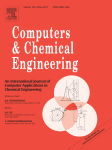 Authors: Luis DOMINGUES¹, Carla I.C. PINHEIRO², Nuno M.C. OLIVEIRA³
Authors: Luis DOMINGUES¹, Carla I.C. PINHEIRO², Nuno M.C. OLIVEIRA³
Affiliations: ¹Departamento de Engenharia Química, Instituto Superior Técnico, Universidade de Lisboa, Av. Rovisco Pais 1, 1049-001 Lisboa, Portugal; ²Centro de Química Estrutural, Instituto Superior Técnico, Universidade de Lisboa, Av. Rovisco Pais 1, 1049-001 Lisboa, Portugal; ³CIEPQPF, Department of Chemical Engineering, Universidade de Coimbra, Rua Sílvio Lima – Pólo II, 3030-790 Coimbra, Portugal
Reference: Domingues, L., Pinheiro, C. I. C., & Oliveira, N. M. C. (2017). Economic comparison of a reactive distillation-based process with the conventional process for the production of ethyl tert-butyl ether (ETBE). Computers and Chemical Engineering, 100, 9–26.
Abstract: “This work addresses the economic comparison of a process based on reactive distillation (RD) with the conventional process for ETBE production. Nonlinear first-principles models for both processes were developed and implemented in gPROMS ModelBuilder, with the corresponding physical properties being calculated in Aspen Plus, connected through the CAPE-OPEN interface. The design of the RD column was performed using an optimisation-based strategy, which couples an evolutionary algorithm with a nonlinear solver.
The RD-based process studied eliminated the need for the top ethanol fresh feed, thus eliminating the need for an ethanol recovery section. The payback period was found to be 3 years, if the RD column, condenser and reboiler are purchased and only 1.5 years if only the cost of purchasing a RD column is considered. The advantages of the RD-based process were found to be the higher yield of ETBE product, as well as lower costs of ethanol and steam.”
DOI: 10.1016/j.compchemeng.2017.01.008
Comments: the authors are using gPROMS Model Builder as a flowsheet simulator since the entire ETBE production process is modeled in gPROMS, not just one unit operation. Each process equipment model is modelled in gPROMS ModelBuilder 3.5.1 while the physical properties are calculated in Aspen Properties 2006.5 and passed to the gPROMS model through CAPE-OPEN interfaces. For example for the distillation column model, VapourFugacityCoefficient and LiquidFugacityCoefficient are properties requested by the gPROMS model. The thermodynamic model used, for the gas phase, is Redlich–Kwong–Soave (RKS) while, for the liquid phase, the UNIFAC method is used to calculate the activity coefficients of the liquid phase. The authors justify their choice of thermodynamic model through many references found in the literature.
